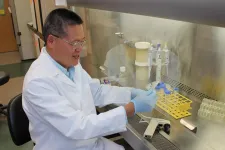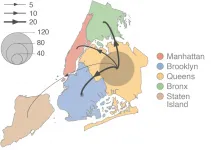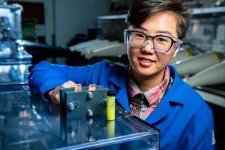Novel immune checkpoints have applications for cancer, autoimmune disease treatment
UConn researcher Laijun Lai has developed recombinant proteins and antibodies to combat autoimmune diseases and immunosuppression in cancer patients
2021-05-20
(Press-News.org) The immune system is a complex balancing act; if it overreacts or underreacts to foreign molecules, there can be serious health consequences.
For cancer patients, tumor progression is often accompanied by immunosuppression, meaning their bodies can't fight off pathogens the way they should. By contrast, for people with autoimmune diseases like type 1 diabetes, rheumatoid arthritis, and multiple sclerosis, their immune systems overreact and attack the body itself.
Both of these reactions are influenced by a series of molecular checkpoints found in both immune cells and cancer cells. In immune cells, these checkpoints are supposed to prevent the immune system from mounting a response that is too strong and attacks healthy cells. For people with autoimmune diseases, these checkpoint molecules do not function properly. In cancer cells, they bind to immune cell receptors and inhibit their function to a degree that makes patients vulnerable to severe illness and infection.
Dr. Laijun Lai, a research professor in the Department of Allied Health Sciences in the College of Agriculture, Health and Natural Resources, has used bioinformatics and gene engineering techniques to develop a series of recombinant proteins and antibodies for a novel set of checkpoint molecules to address both of these concerns. Lai recently published a paper on the effectiveness of this invention in EMBO Molecular Medicine and has a patent pending for this invention.
Scientists made a major breakthrough when they identified several checkpoints, specifically PD-L1, PD-1 and CTLA-4, within the last decade. There are several FDA-approved medications that produce recombinant proteins to treat autoimmune disease, and antibodies to block the inhibitor activity of these checkpoints for cancer patients. However, not all patients respond to these treatments since there are many other checkpoints at work.
Using a bioinformatics approach, Lai identified three additional checkpoints: CD300c, ERMAP, and TAPBPL found in both immune cells and cancer cells. The bioinformatics approach identified the checkpoints that were most likely to be relevant based on their genetic and structural similarities to previously identified molecules.
Each molecule binds to a specific immune cell receptor to send an inhibitory signal and uses different mechanisms to check immune cell responses.
"The expression pattern of our molecules are different from existing checkpoint molecules and, probably, a different subset of patients will respond to them," Lai says.
Lai's group used genetic engineering to develop recombinant proteins from the genetic blueprint of these proteins. Lai has demonstrated that these recombinant proteins can successfully suppress T-Cell function in animal models of autoimmune diseases.
On the other side, Lai's group developed antibodies that can block the inhibitory activity of these checkpoint molecules. He found the antibodies enhance antitumor immunity and inhibit tumor growth in animal models.
These therapies can be combined with exiting antibodies for PD-L1, PD-1 and CTLA-4, or on their own for patients who do not respond to those treatments.
"Our antibodies against these checkpoint molecules have the potential to be used in the treatment of cancer patients who are resistant to the anti-PD-1, PDL1, and CTLA-4 antibodies and can also be used in combination with existing antibodies to enhance the antitumor effects," Lai says.
INFORMATION:
In addition to this recent publication in EMBO Molecular Medicine, Lai and his collaborators have published their findings about this technology in other high-impact journals including Frontiers in Immunology, and Cellular and Molecular Immunology.
Lai's research was supported by more than $7 million total funding from the National Institutes of Health, Connecticut Innovations, and the American Cancer Society.
The next step for this innovation is to use their recombinant human proteins in clinical trials to treat autoimmune disease, develop human antibodies and continue their functional studies with the final goal of using them as novel therapeutics for cancer.
[Attachments] See images for this press release:

ELSE PRESS RELEASES FROM THIS DATE:
2021-05-20
Oysters live and grow in saltwater. However, the saltiness of their habitat can change dramatically, especially where the mighty Mississippi River flows into the Gulf of Mexico. Louisiana oysters from the northern Gulf of Mexico may experience some of the lowest salinity in the world due to the influx of fresh water from the Mississippi River. In addition, increased rainfall and large-scale river diversions for coastal protection will bring more fresh water that does not bode well for the eastern oyster. New research led by Louisiana State University (LSU) alumna Joanna Griffiths from Portland, Oregon, and her faculty advisor ...
2021-05-20
ROCHESTER, Minn. -- You might be older - or younger - than you think. A new study found that differences between a person's age in years and his or her biological age, as predicted by an artificial intelligence (AI)-enabled EKG, can provide measurable insights into health and longevity.
The AI model accurately predicted the age of most subjects, with a mean age gap of 0.88 years between EKG age and actual age. However, a number of subjects had a gap that was much larger, either seemingly much older or much younger by EKG age.
The likelihood to die during follow-up was much ...
2021-05-20
During the pandemic, the old waiting room phrase "the doctor will see you now" has taken on a new meaning. So has the waiting room. Our kitchen table or living room couch is where many people do work lately, and that includes visits to the doctor. New research from Syracuse University's Falk College indicates this method of health care will continue even after COVID numbers are (hopefully) reduced.
"I was surprised by the results," said the study's lead author Bhavneet Walia, assistant professor of public health at Syracuse University. "I initially thought that, because of the challenges of telehealth, physicians would not be in favor of continuing post-pandemic. It turns out they do. But ...
2021-05-20
Researchers have long been interested in finding ways to use simple hydrocarbons, chemicals made of a small number of carbon and hydrogen atoms, to create value-added chemicals, ones used in fuels, plastics, and other complex materials. Methane, a major component of natural gas, is one such chemical that scientists would like to find to ways to use more effectively, since there is currently no environmentally friendly and large-scale way to utilize this potent greenhouse gas.
A new paper in Science provides an updated understanding of how to add functional groups onto simple hydrocarbons like methane. Conducted by graduate students Qiaomu Yang and Yusen Qiao, postdoc Yu Heng Wang, and led by professors Patrick J. Walsh and Eric J. Schelter, this new and highly detailed mechanism ...
2021-05-20
HOUSTON - (May 20, 2021) - It's always good when your hard work reflects well on you.
With the discovery of the giant polarization rotation of light, that is literally so.
The ultrathin, highly aligned carbon nanotube films first made by Rice University physicist Junichiro Kono and his students a few years ago turned out to have a surprising phenomenon waiting within: an ability to make highly capable terahertz polarization rotation possible.
This rotation doesn't mean the films are spinning. It does mean that polarized light from a laser or other source can now be manipulated in ways that were previously out of reach, making it completely visible or completely opaque with a device that's extremely ...
2021-05-20
At the start of the COVID-19 outbreak, a University of Illinois Chicago researcher conducted a survey asking respondents if they experienced health care delays because of the pandemic. In addition to learning about the types of delays, the study also presented a unique opportunity to capture a historic moment at the pandemic's beginning.
Elizabeth Papautsky, UIC assistant professor of biomedical and health information sciences, is first author on "Characterizing Healthcare Delays and Interruptions in the U.S. During the COVID-19 Pandemic Using Data from an Internet-Based Cross-Sectional ...
2021-05-20
During the first phase of the COVID-19 epidemic, New York City experienced high prevalence compared to other U.S. cities, yet little is known about the circulation of SARS-CoV-2 within and among its boroughs. A study published in PLOS Pathogens by Simon Dellicour at Université Libre de Bruxelles, Belgium, Ralf Duerr and Adriana Heguy at New York University, USA, and colleagues describe the dispersal dynamics of COVID-19 viral lineages at the state and city levels, illustrating the relatively important role of the borough of Queens as a SARS-CoV-2 transmission hub.
To better understand how the virus dispersed throughout New York ...
2021-05-20
Ancient pollen samples and a new statistical approach may shed light on the global rate of change of vegetation and eventually on how much climate change and humans have played a part in altering landscapes, according to an international team of researchers.
"We know that climate and people interact with natural ecosystems and change them," said Sarah Ivory, assistant professor of geosciences and associate in the Earth and Environmental Systems Institute, Penn State. "Typically, we go to some particular location and study this by teasing apart these influences. In particular, we know that the impact people have goes back much earlier than what is typically ...
2021-05-20
A compound used widely in candles offers promise for a much more modern energy challenge--storing massive amounts of energy to be fed into the electric grid as the need arises.
Scientists at the U.S. Department of Energy's Pacific Northwest National Laboratory have shown that low-cost organic compounds hold promise for storing grid energy. Common fluorenone, a bright yellow powder, was at first a reluctant participant, but with enough chemical persuasion has proven to be a potent partner for energy storage in flow battery systems, large systems that store energy for the grid.
Development of such storage is critical. When the grid goes offline due to severe weather, for instance, the large batteries under ...
2021-05-20
Wherever ecologists look, from tropical forests to tundra, ecosystems are being transformed by human land use and climate change. A hallmark of human impacts is that the rates of change in ecosystems are accelerating worldwide.
Surprisingly, a new study, published today in Science, found that these rates of ecological change began to speed up many thousands of years ago. "What we see today is just the tip of the iceberg" noted co-lead author Ondrej Mottl from the University of Bergen (UiB). "The accelerations we see during the industrial revolution and modern periods have a deep-rooted history stretching back in time."
Using a global network of over 1,000 fossil pollen records, the team found - and expected to find - a first peak ...
LAST 30 PRESS RELEASES:
[Press-News.org] Novel immune checkpoints have applications for cancer, autoimmune disease treatment
UConn researcher Laijun Lai has developed recombinant proteins and antibodies to combat autoimmune diseases and immunosuppression in cancer patients







